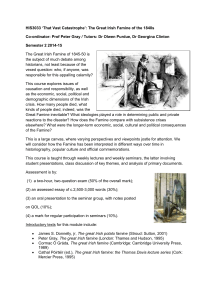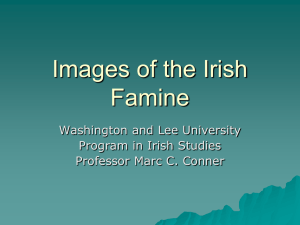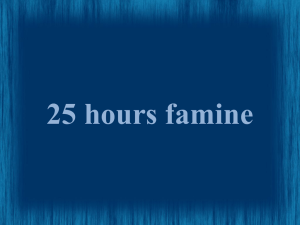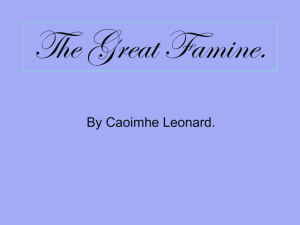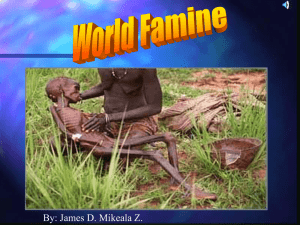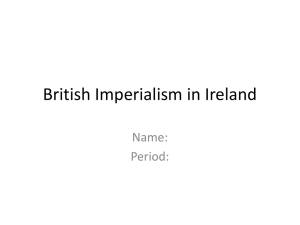Unit Plan on the Great Irish Potato Famine 1845
advertisement
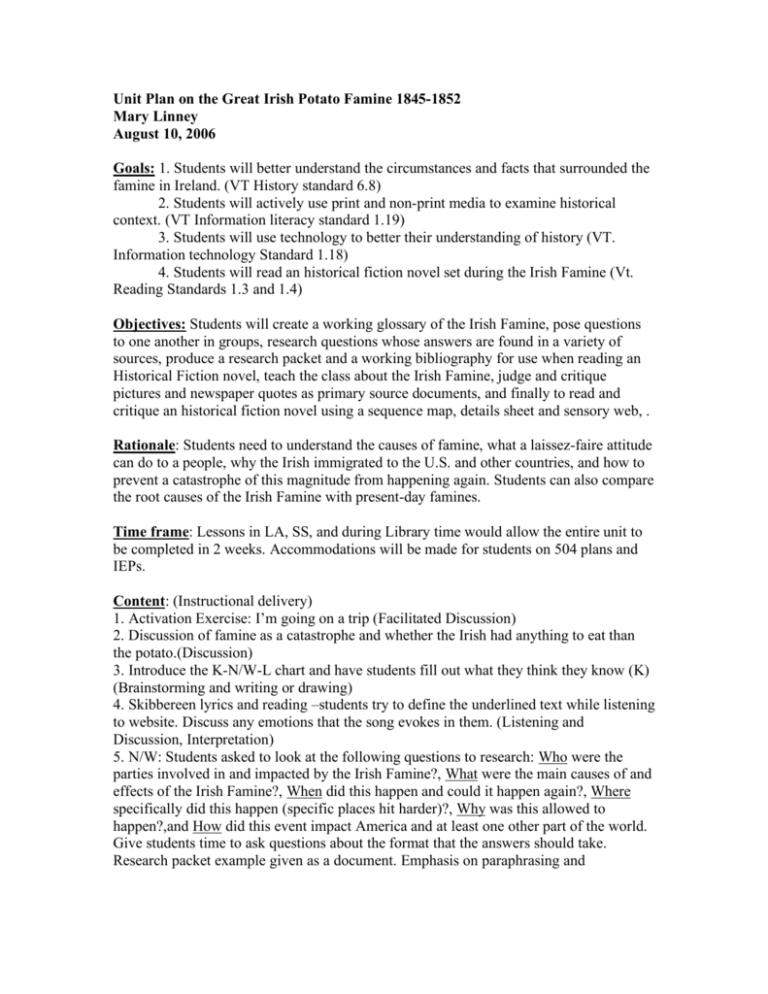
Unit Plan on the Great Irish Potato Famine 1845-1852 Mary Linney August 10, 2006 Goals: 1. Students will better understand the circumstances and facts that surrounded the famine in Ireland. (VT History standard 6.8) 2. Students will actively use print and non-print media to examine historical context. (VT Information literacy standard 1.19) 3. Students will use technology to better their understanding of history (VT. Information technology Standard 1.18) 4. Students will read an historical fiction novel set during the Irish Famine (Vt. Reading Standards 1.3 and 1.4) Objectives: Students will create a working glossary of the Irish Famine, pose questions to one another in groups, research questions whose answers are found in a variety of sources, produce a research packet and a working bibliography for use when reading an Historical Fiction novel, teach the class about the Irish Famine, judge and critique pictures and newspaper quotes as primary source documents, and finally to read and critique an historical fiction novel using a sequence map, details sheet and sensory web, . Rationale: Students need to understand the causes of famine, what a laissez-faire attitude can do to a people, why the Irish immigrated to the U.S. and other countries, and how to prevent a catastrophe of this magnitude from happening again. Students can also compare the root causes of the Irish Famine with present-day famines. Time frame: Lessons in LA, SS, and during Library time would allow the entire unit to be completed in 2 weeks. Accommodations will be made for students on 504 plans and IEPs. Content: (Instructional delivery) 1. Activation Exercise: I’m going on a trip (Facilitated Discussion) 2. Discussion of famine as a catastrophe and whether the Irish had anything to eat than the potato.(Discussion) 3. Introduce the K-N/W-L chart and have students fill out what they think they know (K) (Brainstorming and writing or drawing) 4. Skibbereen lyrics and reading –students try to define the underlined text while listening to website. Discuss any emotions that the song evokes in them. (Listening and Discussion, Interpretation) 5. N/W: Students asked to look at the following questions to research: Who were the parties involved in and impacted by the Irish Famine?, What were the main causes of and effects of the Irish Famine?, When did this happen and could it happen again?, Where specifically did this happen (specific places hit harder)?, Why was this allowed to happen?,and How did this event impact America and at least one other part of the world. Give students time to ask questions about the format that the answers should take. Research packet example given as a document. Emphasis on paraphrasing and summarizing rather than simply copying. One student in each group is responsible for collecting words and definitions to be given to the teacher. (Facilitate discussion) 6. Library access to books, magazines, pamphlets, and websites for 2 days. Each student is out into a heterogeneously mixed group of 4 students (assumes a class of 24) Groups create a research packet and bibliography as well as a word wall while doing active research to answer the six questions. (Assessment on quality of group research and level of understanding; assessment rubric pending) See materials list for bibliography 7. Groups teach the answer to one of the six questions in a game, song, skit, PP presentation or activity that does no require reading. Students given the following URL: http://vassun.vassar.edu/~sttaylor/FAMINE and asked to use one engraving in their teaching presentation.(Assessment rubric on presentation pending) 8. Students are shown 2 slides (6,7) on Power Point that relate to Great Britain. Compare the two pictures. (Facilitated discussion) 9. Decisions slide 8: Given the list of reasons to stay and to leave, would students have remained? (Facilitated discussion.) 10. Implications for women in Australia: slide 9 (continued discussion) 11.. Students given collated glossaries which have been turned into bookmarks for use while reading one of three Historical Fiction novels: Under the Hawthorn Tree, The Haunting of Kildoran Abbey and The Grave. 12. While reading one of the HF novels, students will create either a written chain or events or a storyboard outlining key plot points. (see HF sheets) 13. The choice of language to create details will be introduced in LA class and then applied to the HF novel. (see HF sheets) 14. After finishing novel, students will regroup according to the book that they and critique fact from fiction (see HF sheets) Evaluation: Students will be given list from items 1-13 to be completed; they will also be graded on classroom discussions and enthusiasm for learning. Rubric to follow. Materials and aids: See word document in project folder. Chain of Events Chain of Events is used to describe the stages of an event, the actions of character or the steps in a procedure. It can also be used to describe major story lines or plot points in a novel. Use this to describe key events in your HF novel. Key questions: What is the first step in the procedure or initiating event? What are the next stages or steps? How does one event lead to one another? What is the final outcome? Storyboard A storyboard is a graphic, sequential depiction of a narrative. Students recall major events of the story, then illustrate the events in the squares provided. More square can be added if necessary. Details, it’s all in the details How does the writer help you see the world that he/she is describing? He/she uses words or key passages that place you in the story. A good author shows, without telling. Look for this as you read. List examples below with page numbers: Words: Key Passages: Fact from fiction: sometimes an author of fiction uses fact to enhance the story; sometimes they change fact to suit the story. Find examples as you read, if you can, of places where the author changes history to suit the story or uses fact to really help the story: Fact passages: Fiction passages: Research Packet on the Great Hunger: The 5Ws and an H Question: Who were the parties involved in and impacted by the Irish Famine? Answer in bulleted note form with no complete sentences. Each group must have a minimum of 10 bulleted notes per questions. • _______________________________________________________ • _______________________________________________________ • _______________________________________________________ • _______________________________________________________ • _______________________________________________________ • _______________________________________________________ • _______________________________________________________ • _______________________________________________________ • _______________________________________________________ • _______________________________________________________ Skibbereen Oh father dear, I oft-times hear you speak of Erin's isle Her lofty hills, her valleys green, her mountains rude and wild They say she is a lovely land wherein a saint might dwell So why did you abandon her, the reason to me tell. Oh son, I loved my native land with energy and pride Till a blight came o'er the praties; my sheep, my cattle died My rent and taxes went unpaid, I could not them redeem And that's the cruel reason why I left old Skibbereen. Oh well do I remember that bleak December day The landlord and the sheriff came to take us all away They set my roof on fire with their cursed English spleen I heaved a sigh and bade goodbye to dear old Skibbereen. Your mother too, God rest her soul, fell on the stony ground She fainted in her anguish seeing desolation 'round She never rose but passed away from life to immortal dream She found a quiet grave, me boy, in dear old Skibbereen. And you were only two years old and feeble was your frame I could not leave you with my friends for you bore your father's name I wrapped you in my cota mor in the dead of night unseen I heaved a sigh and bade goodbye to dear old Skibbereen. Oh father dear, the day will come when in answer to the call All Irish men of freedom stern will rally one and all I'll be the man to lead the band beneath the flag of green And loud and clear we'll raise the cheer, Revenge for Skibbereen! Bibliography/Materials list for student use Bartoletti, Susan Campbell. Black Potatoes: The Story of the Great Irish Famine, 18451850. Boston: Houghton Mifflin, 2001. Brassey, Richard and Stewart Ross. The Story of Ireland. Great Britain: Orion Pubs. 2001. Bunting, Eve. The Haunting of Kildoran Abbey. New York: Frederick Warne, 1978. Campbell, Stephen J. The Great Irish Famine: Words and images from the Famine Museum Strokestown Park, County Roscommon. Ireland: Colour Books, 1994. Conlon-McKenna, Marita. Under the Hawthorn Tree Dublin: O’Brien Press, 1990. Dodd, Luke et al. The Great Irish famine & famine today: an activity based education pack for Junior certificate and transition year students. Ireland: Famine Museum Strokestown. Dolan, Edward. The Irish Potato Famine: The story of Irish-American Immigration. New York: Marshall Cavendish, 2003. Heneghan, James. The Grave. New York: Frances Foster Books, 2000. Llywelyn, Morgan and Michael Scott. Ireland: A Graphic History. Dublin: Gill & Mcmillan, 1995. Lyons, Mary E, ed. Feed the Children First: Irish Memories of the Great Hunger. New York: Atheneum Books, 2002 “Potatoes Rot, Famine plagues Ireland”. Calliope. April 2006: entire issue Wilson, Laura. How I survived the Irish Famine: The Journal of Mary O’Flynn. Dublin: Gill & Macmillan, 2000. http://www.cobblestoneonline.net http://www.emsc.nysed.gov/nysssa/gif/curriculum.html http://vassun.vassar.edu/~sttaylor/FAMINE A class set of dictionaries as well as access to the Internet via PCs or laptops or an LCD projector is necessary. Should students choose to create a website or PowerPoint presentation, access must be provided. Index cards, markers, newsprint, post-it notes, pencils, a laminating machine and a copier will be required to complete this unit.

